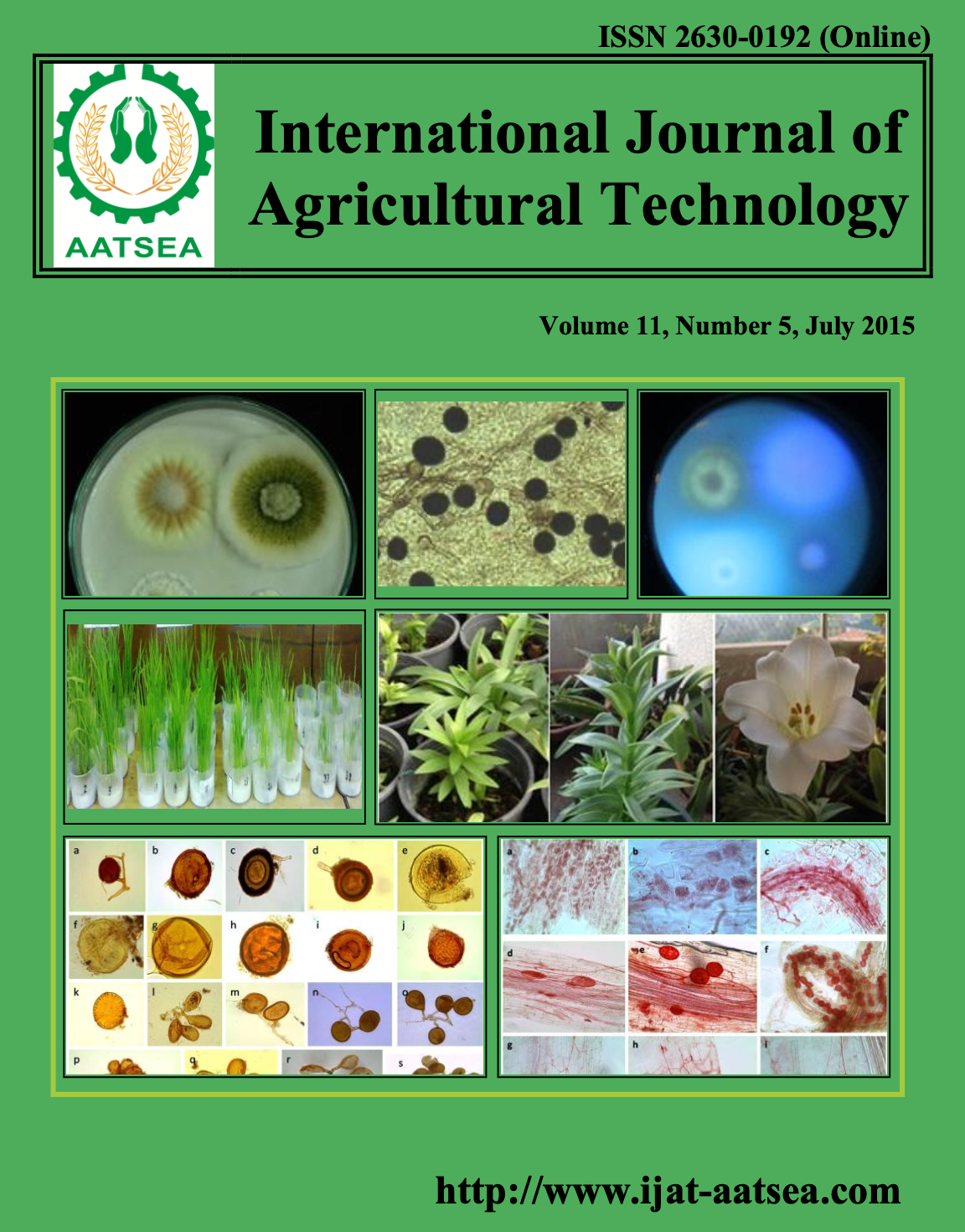Studies on population dynamics of key pests of cotton
Main Article Content
Abstract
The present investigation was aimed to study the population dynamics of key pests of cotton. The highest population of aphids, jassids, thrips, bollworm eggs and larval population of bollworms were recorded in last week of August, 3rd week of September, last week of August, mid September and last week in November, respectively in chemical fertilizer (CF) plot. Whereas, the highest population of whitefly was observed in CF plot and CF + farm yard manure (FYM) plot. Chrysoperla carnea and lady bird beetles were considered for recording their population dynamics. The highest population of Chrysoperla and lady bird beetles were recorded in CF and CF + FYM plots during mid August and mid September. It is clearly evident from the present investigations that the population of most of the sucking pests was maximum during the initial plant growth period and it decreased towards the later crop growth stages.
Article Details

This work is licensed under a Creative Commons Attribution-NonCommercial-NoDerivatives 4.0 International License.
References
CCI (Cotton Corporation India limited) (2014). Current Cotton Scenario. Retrieved from http://cotcorp.gov.in/current-cotton.aspx?pageid=4.
ICAC (International Cotton Advisory Committee) (2013). World Cotton Production and Mill Use: from This Season to the Next. Retrieved from https://www.icac.org/Press-Release/2013/PR-07.
Fakhri, M. S. and Jamal, K. (2012). Population dynamics of major insect pests of cotton in relation to abiotic factors. International journal of advanced Biological Research 2:500-505.
Khan, M. Q. and Rao, V. P. (1960). Insect and mite pest on cotton in India. Indian Cent. Cotton Common. Bombay. pp. 207-301.
Kulkarni, S. N. (1979). Studies on cotton pests complex in relation to crop losses and control. (Doctor of Philosophy’s Thesis). Marathwada Agricultural University, Parbhani.
Mayee, C. D., Gautam, H. C. and Anupam, B. (2004). Cotton scenario in India vis-à-vis world and future needs. Lead papers of national symposium on cotton. pp. 245-253.
Mustafee, T. P. C. (1996). Increasing agricultural production. Pestology. pp. 12-17.
Narayanan, S. S., Singh, V. V., Punit, M. and Vinita, G. (2004). Germplasm and its utilization in cotton improvement- retrospect and prospects. Lead papers of national symposium on cotton. pp. 3-24.
Osti, N. P. and Pandey, S. B. (2006). Use of Whole Cotton Seed and Cotton Seed Meal as a Protein Source in the Diet of Ruminant Animals: Prevailing situation and opportunity. Proceedings of the 6th National Workshop on Livestock and Fisheries Research. pp. 111-119.
Panse, V. G. and Sukhatme, P. V. (1967). Statistical Methods for Agricultural, Workers, ICAR, New Delhi.
Sahito, H. A., Haq, I., Sulehria, M. A. G., Nahiyoon, A. A. and Mahmood, R. (2010). Preliminary studies on egg parasitoids of cotton Jassid Amrasca biguttula biguttula (Ishida). CABI 1-6. Retrieved from https://www.icac.org/tis/regional_networks-/asian_network/ meeting_5/documents/ papers/PapSahitoHA-et_al.pdf.
Sharma, P. D. and Jalan, M. S. (1997). Relative efficacy and persistance of different insecticides for the control of Helicoverpa armigera on Cotton. Pestology 21:12-15.
Singh, J. P. and Lakra, R. K. (1992). Effect of incidence of leaf hopper and bollworms on shedding of fruiting bodies and loss in yield of seed cotton. Proceedings of the 3rd International Conference on Plant Protection in the Tropics, Kaulalampur, Malaysia 6:142-148.
Sohi, G. S. (1964). Pests of cotton. In entomology in India (ed.). Entomology society of India. pp. 111-148.
Spíndola, A. F., Silva-Torres, C. S., Rodrigues, A. R. and Torres, J. B. (2013). Survival and behavioural responses of the predatory ladybird beetle, Eriopis connexa populations susceptible and resistant to a pyrethroid insecticide. Bulltein of Entomological Research 103:485-94.
Taley, Y. M., Thote R. L. and Nimbekar, S. A. (1988). Assessment of losses due to insect pests of cotton and benefit of protection schedule. PKV Research Journal 12:88-91.
USDA, ERS (United States Department of Agriculture, Economic Research Service) (2011). Retrieved from http://www.ers.usda.gov/Briefing/Cotton/ (accessed 18.07.11).
Wilson, L., Herron, G., Smith, T., Heimona, S. Gordon, R., Tracey, Farrell, Hill, J. and Larsen, D. (2008). Strategies to manage aphids in cotton. Retrieved from http:// www.cottoncrc.org.au.


